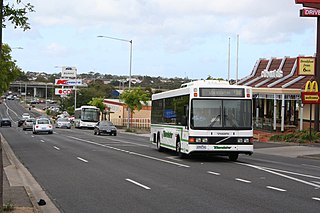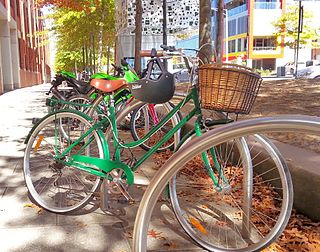Related Research Articles

Geelong is a port city in Victoria, Australia, located at the eastern end of Corio Bay and the left bank of Barwon River, about 75 km (47 mi) southwest of Melbourne. With an estimated population of 282,809 in 2023, Geelong is the second largest city in the state of Victoria. It is the administrative centre for the City of Greater Geelong municipality, which is Port Phillip's only regional metropolitan area, and covers all the urban, rural and coastal reserves around the city including the entire Bellarine Peninsula and running from the plains of Lara in the north to the rolling hills of Waurn Ponds to the south, with Corio Bay to the east and the Barrabool Hills to the west.
James Harrison was a Scottish Victorian newspaper printer, journalist, politician, and pioneer in the field of mechanical refrigeration.

The Barwon River is a perennial river of the Corangamite catchment, located in The Otways and the Bellarine Peninsula regions of the Australian state of Victoria.

The You Yangs are a series of granite ridges that rise up to 319 m (1,047 ft) above the flat and low-lying Werribee Plain in southern Victoria, Australia, approximately 5 km (3.1 mi) due west of the rural town of Little River, 55 km (34 mi) southwest of Melbourne CBD and 22 km (14 mi) north of Geelong. The main ridge runs roughly north-south for about 9 km (5.6 mi), with a lower extension running for about 15 km (9.3 mi) to the west. Much of the southern parts of the ranges are protected by the You Yangs Regional Park.
Lara is a town in Victoria, 18 km north-east of the Geelong CBD, inland from the Princes Freeway to Melbourne. Its population at the 2021 census was 19,014.

Belmont is a southern suburb of Geelong, Victoria, Australia. The name means "beautiful hill". Belmont is geographically separated from the Geelong central business district by the Barwon River. The suburb is primarily residential, with some light industry along Barwon Heads Road. The suburb is part of the City of Greater Geelong local government area. At the 2011 census, Belmont had a population of 13,616.

Barwon Heads is a coastal township on the Bellarine Peninsula, near Geelong, Victoria, Australia. It is situated on the west bank of the mouth of the Barwon River below Lake Connewarre, while it is bounded to the west by farmland, golf courses and the saline ephemeral wetland of Murtnaghurt Lagoon. At the 2016 census, Barwon Heads had a population of 3,875.

South Geelong, also referred to as Geelong South, is a southern suburb of Geelong, Victoria, Australia. Its local government area is the City of Greater Geelong. At the 2016 census, South Geelong had a population of 993.

The Bellarine Peninsula is a peninsula located south-west of Melbourne in Victoria, Australia, surrounded by Port Phillip, Corio Bay and Bass Strait. The peninsula, together with the Mornington Peninsula, separates Port Phillip Bay from Bass Strait. The peninsula itself was originally occupied by Indigenous Australian clans of the Wadawurrung nation, prior to European settlement in the early 19th century. Early European settlements were initially centred on wheat and grain agriculture, before the area became a popular tourist destination with most visitors arriving by paddle steamer on Port Phillip in the late 19th century.

The Field Naturalists Club of Victoria (FNCV) is an Australian natural history and conservation organisation. The club is the oldest of its kind in Australia and is unique in having existed continuously since its foundation. Since its founding, the club has drawn its membership from the ranks of both amateur naturalists and professional scientists. This dual stream of members has continued into the 21st century, in which the club is well known for not only its scientific research output, but also numerous ongoing citizen science projects.
The Australian Natural History Medallion is awarded each year by the Field Naturalists Club of Victoria (FNCV) to the person judged to have made the most meritorious contribution to the understanding of Australian Natural History. The idea originated with J. K. Moir, a book collector and member of the Bread and Cheese Club. Moir wrote to the FNCV in 1939 suggesting that such a medallion should be awarded to a person who had performed, in his words, ‘a signal service’ to the protection of flora and fauna—‘a variation of the Nobel awards’. Nominations for the Medallion are made by field naturalist clubs and kindred bodies from all over Australia, each nomination being valid for a three-year period. The Medallion has usually been awarded annually since 1940. In that time, recipients have been honoured for their work in many fields of natural history studies, and have come from every state and territory in Australia.
John Mayston Béchervaise OAM, MBE was an Australian writer, photographer, artist, historian and explorer. He is especially notable for his work and achievements in Antarctica.

The Geelong Field Naturalists Club (GFNC) is an Australian regional amateur scientific natural history and conservation society which was originally founded in the 1890s and re-established in 1961 in its present form. It is based in Geelong, Victoria, with the aims of preserving and protecting native flora and fauna, promoting the conservation of natural resources and the protection of endangered species and habitats, and recording information and knowledge about the flora and fauna of the Geelong region.

Reedy Lake, historically also known as Lake Reedy, is a shallow 5.5-square-kilometre (2.1 sq mi) intermittent freshwater lake or swamp on the lower reaches of the Barwon River, on the Bellarine Peninsula southeast of Geelong in the Australian state of Victoria.

Newtown & Chilwell Sporting Club, nicknamed the Eagles, is an Australian rules football and netball club based in the inner western suburb of Newtown, Victoria.
The Forrest railway line is a former branch railway in Victoria, Australia. It branched off the Warrnambool railway line at Birregurra, and ran through the foothills of the Otway Ranges to the town of Forrest.
Barwon Football Club was a 19th-century Australian rules football club based in South Geelong, Victoria, and for a brief period during the mid-1870s, was provincial Victoria's strongest football club.
John Robinson Bailey was an Australian politician from 1 October 1859 to 1 July 1861 and Postmaster-General under the Nicholson administration from October 1859 to October 1860. Bailey was born in Leicester, England. He arrived in Australia in June, 1852 and set up a hosiery and outfitting warehouse in Eureka House, Malop Street, Geelong. He stated he had thirteen years experience in London and New York. He later traded as Bailey & Honey.

Cycling in Geelong, Victoria is common for recreation and competition, but less so for utility and commuting.
References
- ↑ Pescott, Trevor. (1978). Natural Victoria. Rigby: Australia. ISBN 0-7270-0524-3
- ↑ Pescott, Trevor. (1995). The You Yangs Range. Yaugher Print: Geelong. ISBN 0-646-23507-9
- ↑ Hewish, Marilyn. (2005). Trevor Pescott. In: Geelong Bird Report 2004: 69-70. Geelong Field Naturalists Club